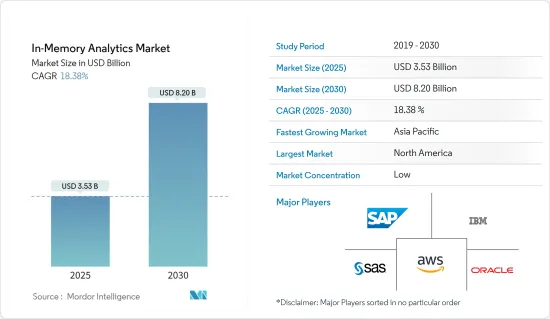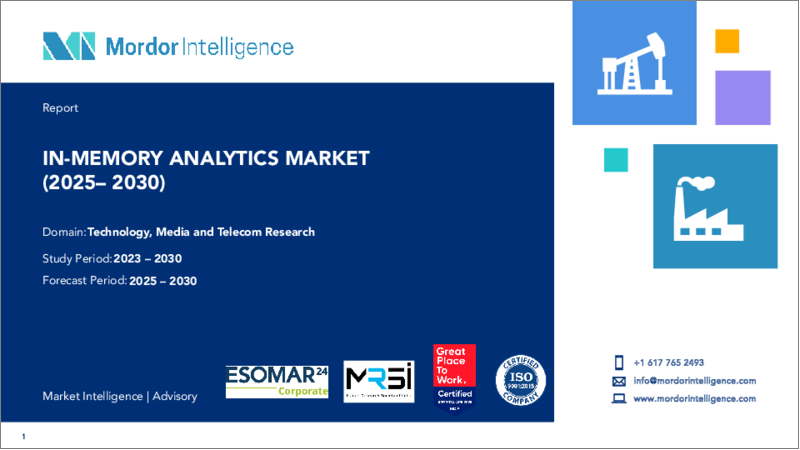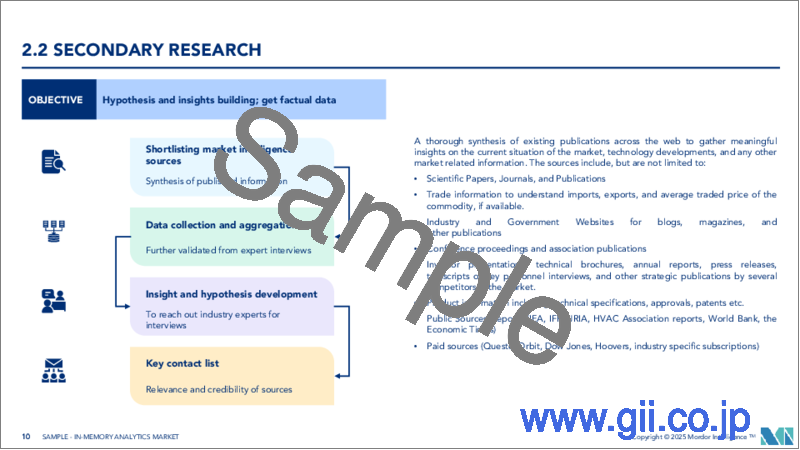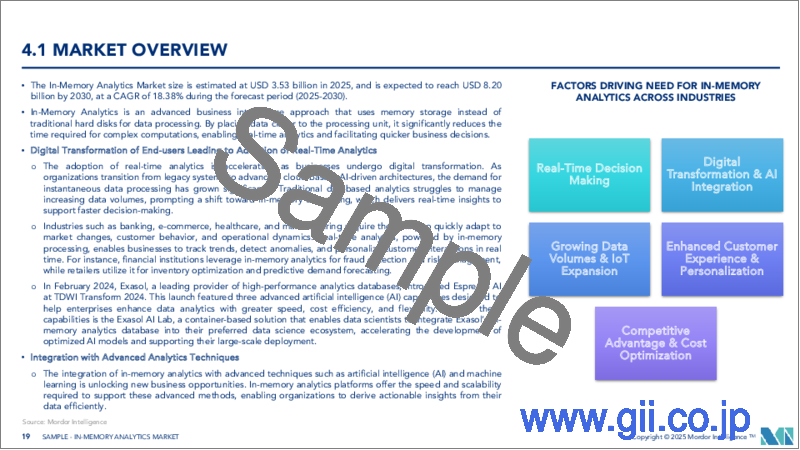|
|
市場調査レポート
商品コード
1641907
インメモリ分析:市場シェア分析、産業動向・統計、成長予測(2025年~2030年)In-Memory Analytics - Market Share Analysis, Industry Trends & Statistics, Growth Forecasts (2025 - 2030) |
||||||
カスタマイズ可能
適宜更新あり
|
|||||||
| インメモリ分析:市場シェア分析、産業動向・統計、成長予測(2025年~2030年) |
|
出版日: 2025年01月05日
発行: Mordor Intelligence
ページ情報: 英文 120 Pages
納期: 2~3営業日
|
全表示
- 概要
- 目次
インメモリ分析の市場規模は、2025年に35億3,000万米ドルと予測され、予測期間中(2025-2030年)のCAGRは18.38%で、2030年には82億米ドルに達すると予測されます。

新しい永続メモリ技術は、最近の動向になりつつあるBMI対応アーキテクチャ(インメモリ・コンピューティング)の採用コストと複雑さを軽減するのに役立ちます。パーシステント・メモリは、DRAMとNANDフラッシュ・メモリの間の新しいメモリ層であり、高性能ワークロードに経済的なマス・メモリを提供することができます。このオプションは、コストを抑制しながら、アプリケーションのパフォーマンス、可用性、起動時間、ロード方法、セキュリティ対策を改善することができます。
主なハイライト
- ハイパーコネクティビティ、クラウドコンピューティング、ビッグデータなどの技術動向は、社会動向やビジネス動向と密接に関係しているため、あらゆる主要産業におけるデジタルトランスフォーメーションは、リアルタイムアナリティクスの採用につながります。これにより、企業はハイブリッド・トランザクション/アナリティカル・プロセッシング(HTAP)戦略の導入を開始することになります。HTAP戦略は、ビッグデータセットに対するリアルタイムの洞察を提供することでデータ処理に革命をもたらす可能性があると同時に、コスト削減を促進します。
- 世界中で継続的に増大するデータ量は、意味のある洞察を生み出し、ビジネス上の意思決定を行うために、これらのデータを保存し、容易にアクセスし、分析するための分析ソリューションに対する需要を生み出しています。インメモリ分析は、ビッグデータの課題を克服するのに役立ちます。インメモリ分析は、データをメモリに保存するため、処理速度が向上し、待ち時間が最小限に抑えられます。データ量の増加には、新たなテクノロジーも貢献しています。
- メタバース、仮想現実、AR(拡張現実)、その他の新興技術は、現在急速に普及しており、構造化データおよび非構造化データをさらに大量に生み出すと予想され、インメモリ分析ソリューションの需要を生み出すと予測されています。ウェアラブルの普及。スマートデバイスとモノのインターネットは市場の成長を促進します。例えばシスコによると、2022年には11億500万台に達すると予測される接続型ウェアラブルデバイスの増加も、データ量の増加に寄与しています。
- しかし、製品に関する認知度の低さや従来の分析ツールの普及率の高さが、市場の成長を抑制しています。インメモリは、技術やアーキテクチャを入れ替えるだけで、すぐに結果が出るわけではないです。そのためには、何が起きているのかを管理するスキルと専門知識が必要だが、それが圧倒的に不足しています。
- COVID-19パンデミックの発生は、あらゆる産業でデジタル技術の採用を加速させ、膨大な量のデータを生み出し、アナリティクス・ソリューションの需要を押し上げました。COVID-19の大流行によってヘルスケアにおけるAR/VRやスマートデバイスの導入が進んだことも、データ主導の意思決定を行うためのアナリティクス・ソリューションの需要を加速させました。このようなソリューションの導入が成功すれば、より多くのベンダーや企業がインメモリ分析・ソリューションを採用するようになり、予測期間中の調査対象市場の成長に道を開くことになると思われます。
インメモリ分析市場の動向
製造業が市場成長を牽引
- インメモリ分析市場では、製造業部門が大きな成長を遂げると予測されます。インダストリー4.0と新技術の進歩が製造業全体の成長を加速。インメモリ分析(IMA)は、欠陥追跡や予測機能を強化してサプライチェーンを改善することで、製造品質の向上とサポートコストの削減を実現し、全体的な業務効率を高めるために、多くの製造企業で利用されるようになっています。
- データウェアハウスのクエリとレポーティングのパフォーマンスは良好でなければならないです。SAP HANAなどのインメモリデータベースの利点の1つは、トランザクションデータを必ずしも専用のデータウェアハウスにコピーする必要がないことです。分析ビューや計算ビューを、運用中のトランザクションテーブルの上に作成し、データのレポートや分析に使用できる次元ビューを作成することができます。
- エンタープライズ・データベースからのインメモリ・ビッグデータ分析は、変化に関するリアルタイムのデータを取得し、マシン・データやセンサー・データと統合することで、オペレーションの全体的なビューを提供し、製造業の生産性を向上させる。動きのあるデータを分析することで、交通状況や設備の状態など、時間的にクリティカルなオペレーション・イベントに対応することができます。
- さらに、製造業のフットプリントの拡大や製造プロセスのデジタル化に対する意識の高まりが、調査対象市場の成長を後押しすると予想されています。例えば、インド産業・国内貿易振興省とMOSPIによると、製造業の年間生産成長率は22年度に11.40%増加しました。
- さらに、コネクテッド・ファクトリーは、各プロセスをより深く理解するためにデバイスや要素の通信を可能にするもので、製造業の未来にとって中心的な存在です。アナリティクスの導入は、コネクテッド・ファクトリーに不可欠な要素です。テクノロジーによって機械、人員、センサーが製造プロセスを通じてシームレスかつ自動化された方法で情報を交換できるスマート工場が増加しています。接続された機器によって生成されたデータは膨大な量の情報を生み出し、エッジ接続と計算技術の助けを借りて、この情報を根本的に新しい方法で分析し理解することができます。
アジア太平洋地域が著しい成長を遂げる
- アジア太平洋地域のインメモリー・アナリティクス市場は、エンドユーザーのデジタル化の進展と、特に中国とインドで中小企業によるコスト効率の高いクラウドベースの分析ソフトウェアの採用が増加していることが原動力となっています。
- 中国、インド、日本などの国々は、BPOやKPOなどの企業のハブとして機能しており、世界的に製造工場としても知られています。このような組織の基本的な基盤は、膨大な量のデータを保存、分析し、意思決定に利用する必要があることです。これがインアナリティクス市場の需要を牽引しています。
- モバイル・テクノロジーとサービスは、アジア太平洋地域の経済において重要な役割を果たし続けています。同地域全体における認知度の向上と4Gおよび5Gの普及率の急増も、分析ソリューションの需要を加速させています。例えば、VIAVI Solutionsによると、中国は2022年に356都市が5Gでカバーされ、フィリピン(105都市)、韓国(85都市)などがこれに続いた。
- これとは別に、デジタルソリューションの採用を促進する政府の取り組みも、アジア太平洋地域の調査対象市場の成長を後押ししています。例えば、インド政府は、国内貿易の推定値、都市化分析、鉄道の自由席利用者分析など、さまざまな目的でビッグデータを利用しています。中国経済は、その優位性を維持し成長を持続させるために、より高い価値やより高度な産業への先端技術の採用を強化する可能性があり、ビッグデータはこのシフトを促進する手段の1つであり、アジア太平洋地域における調査市場の成長を支援します。
インメモリ分析産業の概要
インメモリ分析市場は、複数の主要企業と新規参入企業が競合情勢を形成し、かなりの市場シェアを占めているため、競合情勢が激しいです。また、戦略的パートナーシップ、買収、製品/技術の新規投入により、市場での競争は激化しています。SAP SE、IBM Corporation、SAS Institute, Inc.などが主要企業です。
2023年4月、SAP SEはSAP HANA 2.0 SPS 0.7を更新し、機械学習機能の強化、SDA/SDIアダプタ認証の更新、新しいデータプロビジョニング機能、保持期間を設定したバックアップ&リカバリなどの重要な機能を追加しました。SAP HANAの最新バージョンは、TCO、スケーラビリティ、信頼性、ユーザーエクスペリエンスの面で多くの改善を提供しています。インメモリーコンピューティングを合理化し、民主化することで、組織内のさらに多くの人々が迅速な対応と価値ある洞察を得られるようになります。
2023年3月、ExasolはIn-Memory Analytics Databaseの新リリースと機能強化を発表しました。同社は、この新しいリリースは、コスト、パフォーマンス、柔軟性の間で妥協する必要のないソリューションを顧客に提供することへの献身を示すものであるとしています。
その他の特典
- エクセル形式の市場予測(ME)シート
- 3ヶ月間のアナリスト・サポート
目次
第1章 イントロダクション
- 調査の前提条件と市場定義
- 調査範囲
第2章 調査手法
第3章 エグゼクティブサマリー
第4章 市場洞察
- 市場概要
- 産業バリューチェーン分析
- 業界の魅力度-ポーターのファイブフォース分析
- 買い手/消費者の交渉力
- 供給企業の交渉力
- 新規参入業者の脅威
- 代替品の脅威
- 競争企業間の敵対関係の強さ
第5章 市場力学
- 市場促進要因
- リアルタイム分析の採用につながるエンドユーザーのデジタルトランスフォーメーション
- 迅速な分析手法を求めるデータ量の増加
- 計算技術の進歩
- 市場抑制要因
- エンドユーザーの認識不足
第6章 市場セグメンテーション
- 展開別
- オンプレミス
- クラウド
- エンドユーザー産業別
- BFSI
- 小売
- IT・通信
- 製造業
- 政府・公共機関
- その他エンドユーザー産業
- 地域別
- 北米
- 欧州
- アジア太平洋
- ラテンアメリカ
- 中東・アフリカ
第7章 競合情勢
- 企業プロファイル
- SAP SE
- IBM Corporation
- Oracle Corporation
- Activeviam
- Amazon Web Services, Inc.
- Information Builders, Inc.
- Kognitio Ltd.
- Microstrategy Incorporated
- SAS Institute, Inc.
- Software AG
第8章 市場機会と今後の動向
第9章 投資分析
The In-Memory Analytics Market size is estimated at USD 3.53 billion in 2025, and is expected to reach USD 8.20 billion by 2030, at a CAGR of 18.38% during the forecast period (2025-2030).

New persistent memory technologies will help reduce the costs and complexity of adopting BMI-enabled architectures (in-memory computing), which is becoming a trend nowadays. Persistent memory represents a new layer of memory between the DRAM and NAND flash memory, which can provide economical mass memory for high-performance workloads. This option can improve application performance, availability, boot times, load methods, and security practices while controlling costs.
Key Highlights
- Digital transformation across all major industries leads to the adoption of real-time analytics as technology trends such as hyper-connectivity, cloud computing, and big data go hand-in-hand with social and business trends. It will enable enterprises to start implementing hybrid transactional/analytical processing (HTAP) strategies, which have the potential to revolutionize data processing by providing real-time insights into big data sets while simultaneously driving down costs.
- The continuously growing volumes of data worldwide create demand for analytics solutions to store, easily access, and analyze this data to generate meaningful insights and make business decisions. In-memory analytics helps organizations overcome the challenges of big data as it is stored in memory that boosts speed and minimizes latency. The emerging technologies further contribute to growing data volume.
- The metaverse, virtual reality, augmented reality, and other emerging technologies are gaining traction nowadays and are expected to further create huge amounts of structured and unstructured data, projected to create demand for in-memory analytics solutions. The growing proliferation of wearables. Smart devices and the Internet of Things fuel the market growth. For instance, according to Cisco, the growth in connected wearable devices, which was forecasted to reach 1,105 million devices in 2022, also contributes to the growing volume of data.
- However, the lack of awareness about the product and higher penetration of conventional analytics tools is restraining the market growth. In-memory may not immediately produce the results; one should desire simply by swapping out technologies and architecture. It requires skills and expertise to manage what's happening, which is profoundly lacking.
- The outbreak of the COVID-19 pandemic accelerated the adoption of digital technologies across all industries and created a huge amount of data which drove the demand for analytics solutions. The increased adoption of AR/VR and smart devices in healthcare due to the COVID-19 pandemic also accelerated the demand for analytics solutions to make data-driven decisions. The successful implementation of such solutions will likely encourage more vendors and businesses to adopt in-memory analytics solutions, paving the way for the studied market's growth during the forecast period.
In-Memory Analytics Market Trends
Manufacturing Sector to Drive the Market Growth
- The manufacturing sector is expected to witness significant growth in the in-memory analytics market. Industry 4.0 and new technology advancements accelerated growth across the manufacturing sector. In-Memory-Analytics (IMA) is increasingly used by many manufacturing organizations to improve manufacturing quality and reduce support costs by enhancing defect tracking and forecasting capabilities to improve supply chains, resulting in overall operational efficiencies.
- The query and reporting performance of the data warehouse should be good. One of the advantages of in-memory databases, such as SAP HANA, is that the transactional data does not necessarily need to be copied to a dedicated data warehouse. Analytical or calculation views can be created over the operational, transactional tables to create a dimensional view that can be used to report and analyze the data.
- In-memory Big Data analytics from enterprise databases is capturing real-time data on change and integrating it with machine data and sensor data to provide a holistic view of operations, thereby enhancing productivity in the manufacturing industry. Data-in-motion is analyzed to react to time-critical operational events, such as traffic or equipment conditions.
- Furthermore, the expanding footprint of manufacturing industry and the increasing awareness about digitization of manufacturing processes are anticipated to support the growth of the studied market. For instance, according to the Department for Promotion of Industry and Internal Trade (India) and MOSPI, the annual growth rate of production in the manufacturing industry increased by 11.40% in FY22.
- Moreover, the connected factory is at the center to the future of manufacturing, as it enables devices and elements to communicate in order to gain a better understanding of each process. Implementing analytics is an essential component of a connected factory. The increased smart factories where the technology enables machines, personnel and sensors to exchange information in a seamless and automated manner throughout the manufacturing process. Data generated by connected equipment generates a vast amount of information, and with the aid of edge connectivity and computational technology, this information can be analysed and understood in radically new ways.
Asia-Pacific to Witness Significant Growth
- The in-memory analytics market in the Asia-Pacific region is driven by the growing digitization of end-users and the rising adoption of cost-effective cloud-based analytical software by SMBs, especially in China and India.
- Countries such as China, India, and Japan act as hubs for enterprises such as BPOs and KPOs and are also known as manufacturing factories worldwide. The very basic foundation of such organizations is the huge quantities of data that need to be stored, analyzed, and used for decision-making. This drives the demand for the in-analytics market.
- Mobile technology and services continue to play an important role in the economy of Asia-Pacific. The growing awareness and a surge in 4G and 5G coverage across the region also accelerate the demand for analytics solutions. For instance, according to VIAVI Solutions, China was the leading country in the Asia-Pacific region in terms of 5G availability in most cities, as the country had 356 cities covered by 5G in 2022, followed by countries such as the Philippines (105), and South Korea (85), among others.
- Apart from this, government initiatives promoting the adoption of digital solutions also drive the growth of the studied market in the Asia-Pacific region. For instance, the Indian government uses big data for various purposes, such as getting an estimate of trade in the country, urbanization analysis, and unreserved railway passengers analysis. To maintain its edge and sustain its growth, China's economy may also enhance its adoption of advanced technologies to a higher value and in more advanced industries, with big data as one of the instruments to facilitate this shift, which will aid the growth of the studied market in the Asia-Pacific region.
In-Memory Analytics Industry Overview
The in-memory analytics market is competitive as several key players and new entrants form a competitive landscape, accounting for a substantial market share. Also, strategic partnerships, acquisitions, and new launches of product/technology are increasing high rivalry in the market. SAP SE, IBM Corporation, SAS Institute, Inc., and others are key players.
In April 2023, SAP SE updated its SAP HANA 2.0 SPS 0.7 with significant features such as enhanced machine learning capabilities, updated SDA/SDI adapter certifications, new data provisioning capabilities, backup & recovery with retention periods, and others. The newest version of SAP HANA offers many improvements in terms of TCO, scalability, reliability, and user experience. It streamlines and democratizes in-memory computing, allowing even more people within your organization to get quick responses and valuable insights.
In March 2023, Exasol announced new releases and enhancements to its In-Memory Analytics Database. The company states that the new release demonstrates its dedication to providing its customers with a solution that does not necessitate compromise between cost, performance, and flexibility.
Additional Benefits:
- The market estimate (ME) sheet in Excel format
- 3 months of analyst support
TABLE OF CONTENTS
1 INTRODUCTION
- 1.1 Study Assumptions and Market Definition
- 1.2 Scope of the Study
2 RESEARCH METHODOLOGY
3 EXECUTIVE SUMMARY
4 MARKET INSIGHTS
- 4.1 Market Overview
- 4.2 Industry Value Chain Analysis
- 4.3 Industry Attractiveness - Porter's Five Forces Analysis
- 4.3.1 Bargaining Power of Buyers/Consumers
- 4.3.2 Bargaining Power of Suppliers
- 4.3.3 Threat of New Entrants
- 4.3.4 Threat of Substitute Products
- 4.3.5 Intensity of Competitive Rivalry
5 MARKET DYNAMICS
- 5.1 Market Drivers
- 5.1.1 Digital Transformation of End-users Leading to Adoption of Real-Time Analytics
- 5.1.2 Growing Data Volume Demanding Swift Analytical Methods
- 5.1.3 Advancements in Computational Technology
- 5.2 Market Restraints
- 5.2.1 Lack of Awareness in End-users
6 MARKET SEGMENTATION
- 6.1 By Deployment
- 6.1.1 On-Premise
- 6.1.2 Cloud
- 6.2 By End-user Industry
- 6.2.1 BFSI
- 6.2.2 Retail
- 6.2.3 IT and Telecommunications
- 6.2.4 Manufacturing
- 6.2.5 Government and Public Sector
- 6.2.6 Other End-user Industries
- 6.3 By Geography
- 6.3.1 North America
- 6.3.2 Europe
- 6.3.3 Asia-Pacific
- 6.3.4 Latin America
- 6.3.5 Middle East & Africa
7 COMPETITIVE LANDSCAPE
- 7.1 Company Profiles
- 7.1.1 SAP SE
- 7.1.2 IBM Corporation
- 7.1.3 Oracle Corporation
- 7.1.4 Activeviam
- 7.1.5 Amazon Web Services, Inc.
- 7.1.6 Information Builders, Inc.
- 7.1.7 Kognitio Ltd.
- 7.1.8 Microstrategy Incorporated
- 7.1.9 SAS Institute, Inc.
- 7.1.10 Software AG





